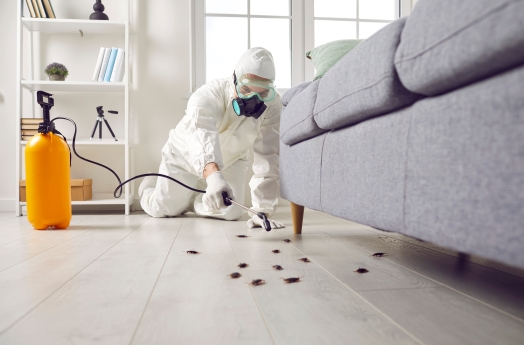The German cockroach may only live for three or four months, but during that short time, a female will lay over 200 eggs and is capable of reproducing without a partner. Controlling cockroaches in residential buildings takes effort from landlords, exterminators and tenants. In pest control circles, treatments for German cockroaches rank high on the list.
When the weather turns colder, the cockroach radar in multi-residential properties goes up. Partnered with a plan for consistent pest control treatments, cleanliness on the part of the unit occupants is a vital part of the insect’s eradication.
“If the resident is rigid in cleaning their property that’s really going to help the issue,” says Shaw Haghgoo, CEO of Pest B Gone Canada Inc., who has learned a thing or two about cockroaches over the years he’s been in business. He explains that a pregnant female will look for nooks and crannies to lay her eggs. From there, the egg hatches and becomes an infant and then an adult.
Vacuuming can really help, but a big issue is that many residents only have mops.
 “A lot of residents don’t want to vacuum because they don’t have carpets,” Haghgoo explains. “Cockroaches lay their eggs in corners and crevices, not in the middle of the floor. With a vacuum, you can get into the baseboards and corners.”
“A lot of residents don’t want to vacuum because they don’t have carpets,” Haghgoo explains. “Cockroaches lay their eggs in corners and crevices, not in the middle of the floor. With a vacuum, you can get into the baseboards and corners.”
Once vacuumed up, the contents of the vacuum bag should be disposed of outside the unit before the collected eggs hatch. He suggests purchasing a bagless vacuum, if possible, and tightly sealing garbage bags before throwing them out completely.
“Some people don’t empty the garbage every day. These insects hatch in the garbage can and then crawl out.”
According to Haghgoo, a secondary issue is that frustrated residents run to pick-up do-it-yourself products which have a weaker active ingredient than the products available to licensed exterminators. “That actually counteracts what we’re doing,” he cautions, explaining that the use of such products leads pests to build up an immunity to the product making it more difficult to treat.
The exterminators themselves are responsible for carefully considering which chemicals are used to provide the most efficacy. “When we repeatedly use the same active ingredient, we create resistance. The exterminator has to maintain a logbook and consider what has been applied previously in the property, and how frequently it can be applied. Is it time to change to a product with a different active ingredient?”
Haghgoo says that the vehicles driven by the Pest B Gone exterminator team carry tanks containing different chemical groups, making it easy and quick for their staff to change up the product used.
 “Manufacturers have given the active ingredients grouping numbers—there could be 10 different products in group 1, while group 2 uses different chemicals. Changing up the active ingredients is key with cockroaches.”
“Manufacturers have given the active ingredients grouping numbers—there could be 10 different products in group 1, while group 2 uses different chemicals. Changing up the active ingredients is key with cockroaches.”
In apartment buildings, cockroaches travel along the plumbing lines making use of warm, moist areas.
“They use every type of tubing as their highway from one unit to another. If you’ve got a problem with cockroaches, it may not be your unit—it’s not necessarily the one next to you either.”
Haghgoo cautions that many people don’t understand the number of parasites and pathogens that cockroaches carry and how much of a health risk they pose.
“Every part of their body is contaminated,” he says. “They’re known for Salmonella and E. Coli, and they’re nocturnal, so while you’re sleeping, they’re out there feasting. They walk over utensils, pots and pans, and throughout your pantry.”
He stresses that a cockroach infestation should never be ignored. “It’s critical that the issue is addressed.” Cockroaches can also be brought in from a trip to the grocery store and have a particular fondness for hops and barley. “Cockroaches love beer. They are drawn to the spill from broken bottles at beer stores, and the dark boxes they can hide in. The German cockroach is the most common cockroach variety in Canada, and it likes to be near humidity, moisture and warmth.”
When approached by a building manager receiving complaints about the crawling insects, Pest B Gone will begin treatment, and then return in ten days to see the progress.
“When we start to see a lot of dead cockroaches, we’ve hit the right chemical,” Haghgoo says. “We make a note of what’s worked and that the same chemical is not to be used past that generation. Each cockroach can create six generations, so we do not want to use that same chemical on the second generation as it will create a resistance.”
If you have an issue with cockroaches, the first thing to do is reduce the amount of clutter that is kept in closets and cupboards. Transferring food to airtight containers can be very helpful, as is decluttering the pantry.
“If you have an over cluttered pantry, you can never monitor it. This is an area which should be vacuumed using the small nozzle on the vacuum cleaner and especially around where the pipes are going through the wall. Vacuum around your baseboards, and behind the fridge if you can reach there. Areas where we get a low volume hum—like the compressor on a refrigerator—are areas where we find more cockroaches.”
He warns that it’s rare to find “just one” cockroach. For severe infestations, Pest B Gone uses a ‘fogging’ method which can reach all areas of an apartment, but still won’t kill cockroach eggs.
“Our pesticides are designed to kill the insects, but during the egg stage they are safe,” he explains. “As soon as they hatch, they want to eat. If there’s bait waiting for them, we’re going to get it under control.”
There is one final warning for building owners and managers: mice love cockroaches, says Haghgoo.
“In buildings that are heavily infested with cockroaches, mice multiply just as quickly. We have treatments for mice and cockroaches and recommend combining treatments at the same time.”
Pest B Gone service all through the Greater Toronto and Hamilton region, including Kitchener/Waterloo. Connect at www.pbgcanada.ca or 289-597-BUGS (2847)






